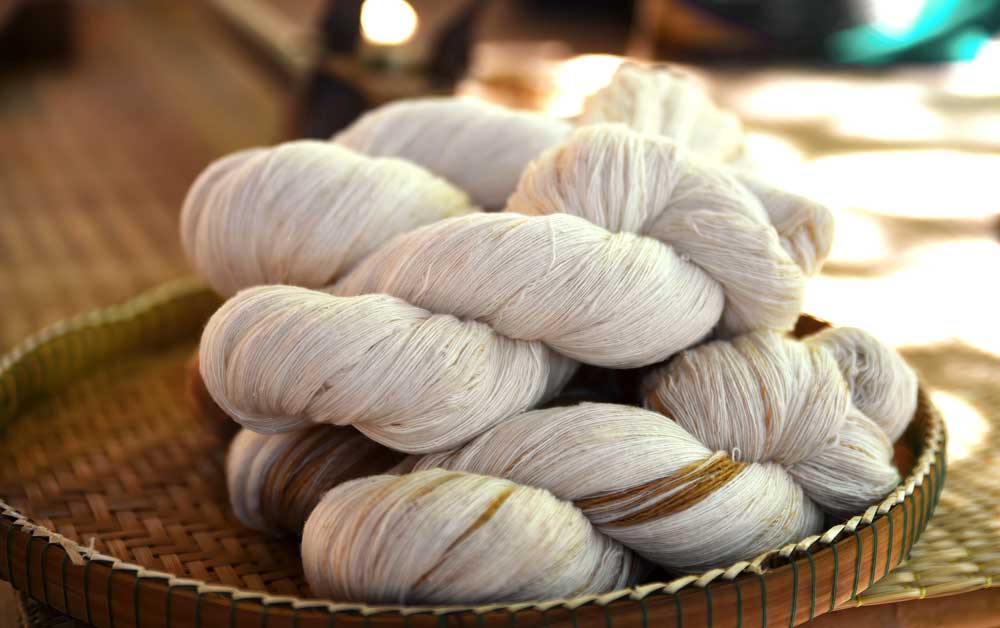India is home to most of the world’s natural plant fibre, and so vegan handlooms aren’t a newvphenomenon. After all, the cotton industry in India has been burgeoning for centuries now. However, it can consume significant amounts of water, labour and other resources to manufacture. Recycled and organic cotton substitutes can reduce this negative environmental impact to a very large extent; however, we sometimes need to look beyond cotton to provide handloom solutions that are both vegan and sustainable.
Linen, of course, has been a great alternative, created from the flax plant. It is biodegradable and resilient as well. But there are other plant-based alternatives that are slowly making inroads into the mainstream handloom market today, such as hemp, jute, bamboo, and banana fibres.
Neesha Amrish, Founder of Aeshane, a conscious clothing brand says, ‘The first thing that resonates when you look at hemp, jute, banana and bamboo bundled together is that all these are natural plant-based fibres that are fully biodegradable and have no negative effect on the environment. They can thus be categorised as eco-friendly fibres. Weaving with natural fibres is always slow and takes time since the process is wholly organic. Hence the fibres tend to be more expensive than man-made fabrics. In recent times hemp has become synonymous with sustainable luxury because the fabric is breathable and drapes well making it a great choice for luxury clothing like dresses and loungewear.’
Hemp is a beautiful fabric that can grow without chemical fertilizers or pesticides, and is therefore easily available organically. It is highly breathable and lightweight, exuding a laidback vibe for those seeking cotton and linen alternatives. Bamboo fabric, pulped from bamboo stems, is also catching on as a vegan handloom alternative. In addition to all its other benefits, it is also naturally hypoallergenic, making it a promising prospect for feminine hygiene products such as underwear and cloth sanitary napkins.
The jute industry in India has long been viewed as a poor cousin to its silk and cotton counterparts, but that isn’t necessarily the case anymore. Once relegated to the use of burlap sacks or covering on construction sites, this ancient fabric has had a revival of sorts and is today used by handloom women weavers in Eastern States like West Bengal and Orissa to create garments like shirts and saris. In fact, India accounts for an estimated 75 per cent of the global jute production. In 2023 alone, the country produced 1.24 metric tonnes of goods from jute. Because of their sturdy, thick nature, jutes have been used for packaging and accessories such as bags and wastepaper baskets, but today it is also used to make beautiful handloom clothing with a high density, resistant to heat and moisture.

Neesha adds, ‘Banana silk is made from the stems of banana plants. These are mostly used to make rugs that are soft and have a beautiful lustre.’ Of late, banana fibre is making headway into the handloom industry as a game changer. These especially appeal to those who want vegan handlooms that resemble the lustre of silk. Countries like Philippines and Japan are already actively involved in the production of this fibre, which is why banana silk is also known as ‘Manila Hemp’. Although the fruit of the banana tree is popular, the stems aren’t consumed or used to maximum capacity. The handloom industry has the potential to fill this gap while also providing an eco-friendly alternative. The fibres are extracted from banana stems in a time-consuming manual process. They are then carefully dried and laminated to remove any excess moisture without breaking the fibre, and woven in the looms. Alongside pure banana silk, the fibre can also be used in blended cottons. They have a naturally high cellulose content, which makes them a reinforcement agent.
Parikrama Chatterji who oversees an export weaving unit in Uttar Pradesh says, ‘Wool and silk are categorised as handloom fabrics, but these are animal-based. Consumers are evolving, and these shifting priorities mean that they’re consciously trying to switch to plant-based alternatives. As a consumer, you should first educate yourself and ensure that you are aware of what fabrics come under the umbrella of vegan handlooms. Once that is done, check that you are buying from a reputed source. It is ideal if they have certifications and labels. Check out the brand or store and verify that they are transparent about their processes. Purchase and consume mindfully. Just because you’re picking up eco-friendly bio-degradable fabric, it doesn’t mean you can indulge in excesses. The same rules and consumption patterns of fast fashion must apply here as well.’
As we become more conscious of what we consume and put into our bodies, the next logical step is to ensure that what we wear follows the same ideology!